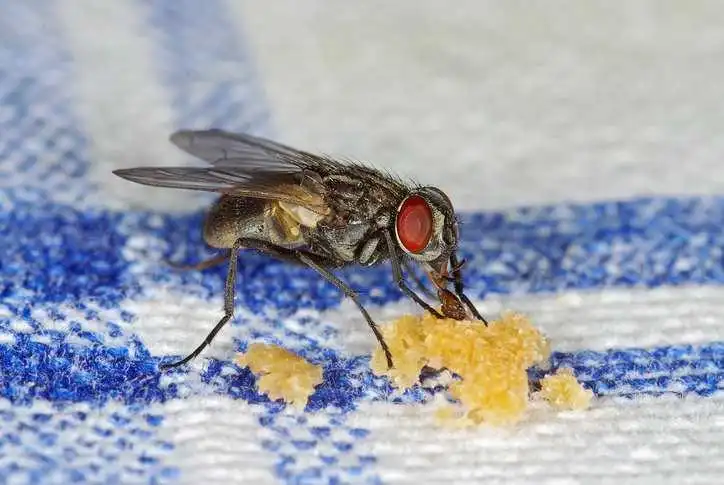House Flies and Food Safety

You might not recognize the presence of the housefly, Musca domestica, until you hear it buzzing in your ear, but it is nearly ubiquitous in all kinds of homes, workplaces, and other facilities. While its life is short, the house fly occupies its time by tasting the surfaces it lands on. With this, houseflies are more than a nuisance; as pests, they can be vehicles for bacteria, making them a threat for food safety.
What Are Houseflies and Where Do They Come From?
The relationship between humans and pests is one of dependency and development that traces back to the dawn of civilization. In the days when human society shifted from nomadic hunter-gatherers to agrarian settlements, the human species reaped many benefits: large population centers, surplus food, economic stability, etc. Other species also seized the opportunity, becoming pests. While the remnants of flies hardly persist enough to make a noticeable impact on the archaeological record, it is known that the housefly originated on the Steppes of Central Asia.
The house fly is a small creature, typically 6 to 7 mm long. Its head is identifiable by its reddish-eyes and sponging mouthparts, its thorax marked by four narrow black stripes, and its abdomen notable for being gray or yellowish with a dark midline. Any entomology enthusiasts who want to differentiate between males and females can look for a handful of physical features of note: the female is typically larger than the male and has a relatively wider space between the eyes; for males, the eyes almost touch, and their underside is yellowish.
Housefly lives are short, with an average of 15 to 25 days, but their species persists because they can reproduce new generations at incredibly fast rates. A single female can lay up to 500 eggs over a 3-to-4-day period. As long as houseflies have access to food, particularly sugar, they can survive.
While house flies can be and are often found in the home as their name might imply, they typically thrive in agricultural areas, where they breed in manure and other organic waste. They develop in significant numbers in poultry manure, but they are also common in hog farms. The contact the flies have with these surfaces enables them to transfer disease.
How Can Houseflies Spread Bacteria?
By simply landing on food, flies can pose a potential health risk. For insects like flies, the first point of contact with a food source is their legs. When the housefly’s legs are stimulated by a food source that it finds appetizing, its mouthparts extend for consumption. Likewise, if the fly’s legs make contact with aversive compounds, they don’t extend their mouthparts. This biological function of tasting with their legs prevents flies from accidentally consuming something harmful. However, it also means that their legs make contact with every surface they touch, whether it be chicken manure or your apple moments before you take a bite out of it.

It should be noted that flies do like to keep themselves clean, as it allows them to be in optimal condition for flying. House flies regularly groom themselves by rubbing their legs together and wiping their antennae, and they tend to remove dirt and debris from the hairs and bristles coating their body, which are highly sensitive and detect air currents and monitor body position. However, this does mean that houseflies can shed this dirt inside homes and food handling facilities.
Houseflies are known to carry E. coli, salmonella, and other harmful bacteria and pathogens. The sanitation issue here can be substantial—one study showed that houseflies were able to transfer E. coli to food in as little as five minutes. Beyond the bacteria that houseflies pick up, they also pose food contamination risk from their vomit and in the excretion products from their alimentary canal.
With their strong single pair of wings, houseflies can travel up 2 miles (and possibly even farther), meaning that they can spread disease beyond their immediate vicinity.
How Do Food Safety Standards Address Houseflies?
While ISO 22000, the international standard for food safety management system (FSMS) requirements, does not mention flies, it does include a provision for considering pest control. From Clause 8.2.3:
“When selecting and/or establishing PRP(s), the organization shall ensure that applicable statutory, regulatory and mutually agreed customer requirements are identified. The organization should consider: […]
d) pest control, waste and sewage disposal and supporting services”
This is among the numerous generic requirements the standard provides. Overall, ISO 22000 outlines requirements for organizations directly or indirectly involved with the food chain to plan, implement, operate, maintain, and update an FSMS, enabling these organizations to demonstrate compliance with regulatory requirements and meet the expectations of customers and other stakeholders.
About ANAB Food Safety Management Systems Accreditation
ANAB accredits organizations that issue certifications to ISO 22000 and other food safety management systems, including accreditation programs for FSSC 22000, FAMI-QS, and the FDA Food Safety Modernization Act (FSMA). ANAB accreditation provides certification bodies with international recognition and integrity that passes down to the food safety management systems being certified.






